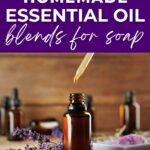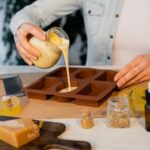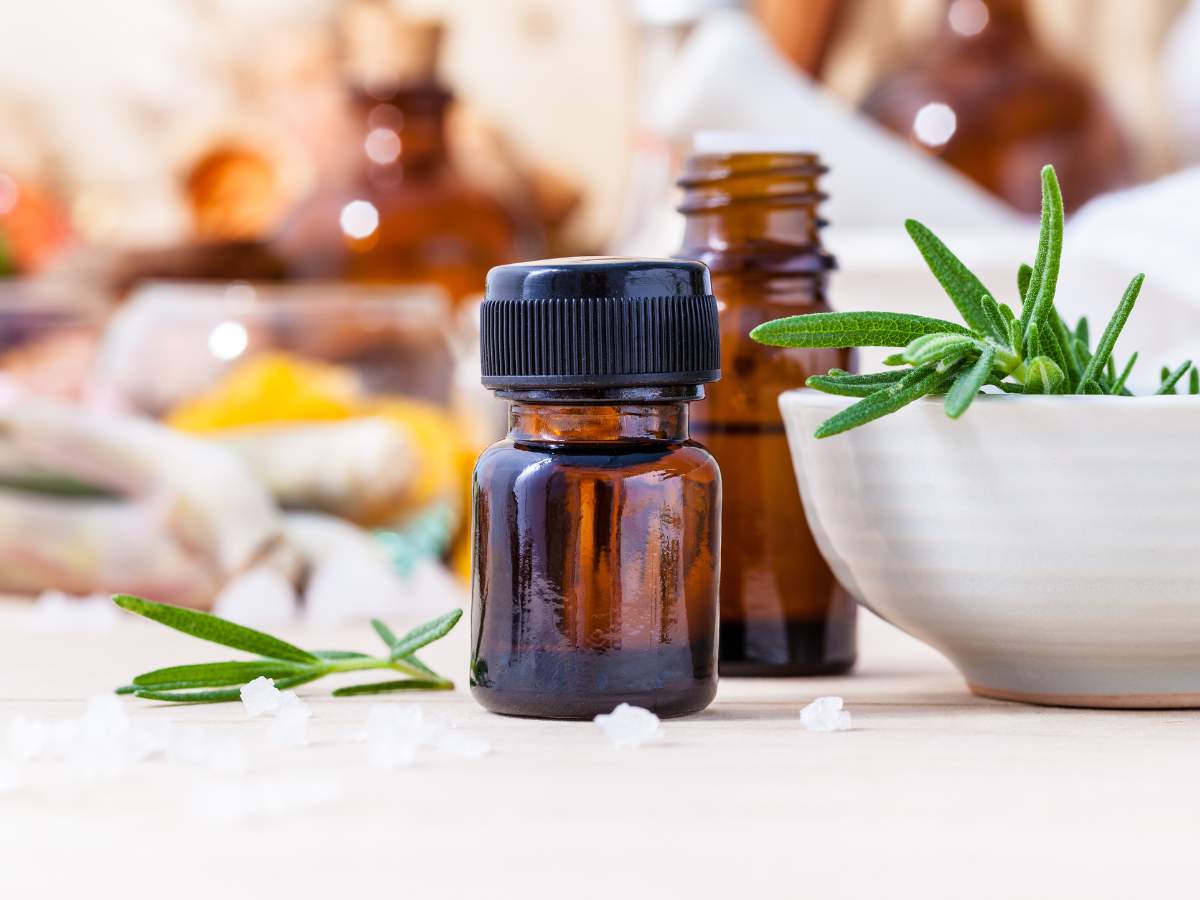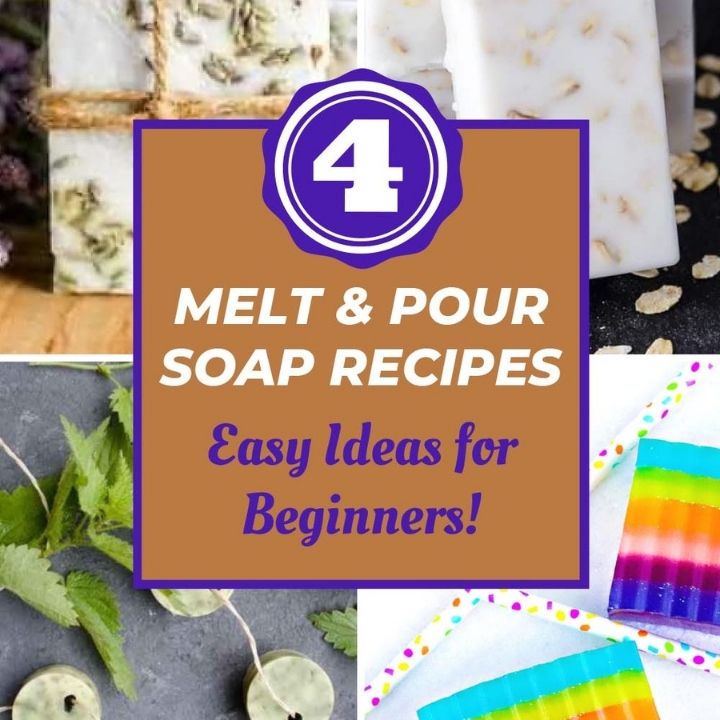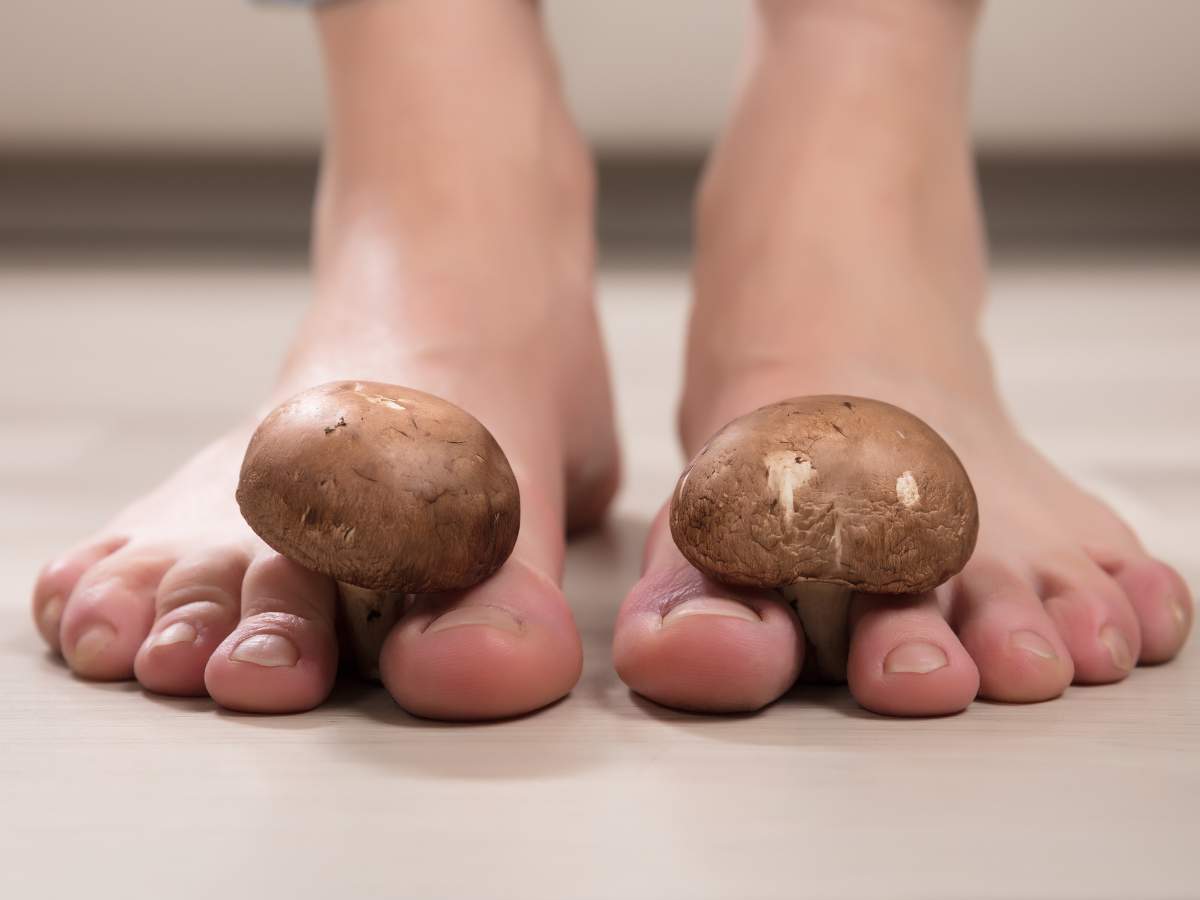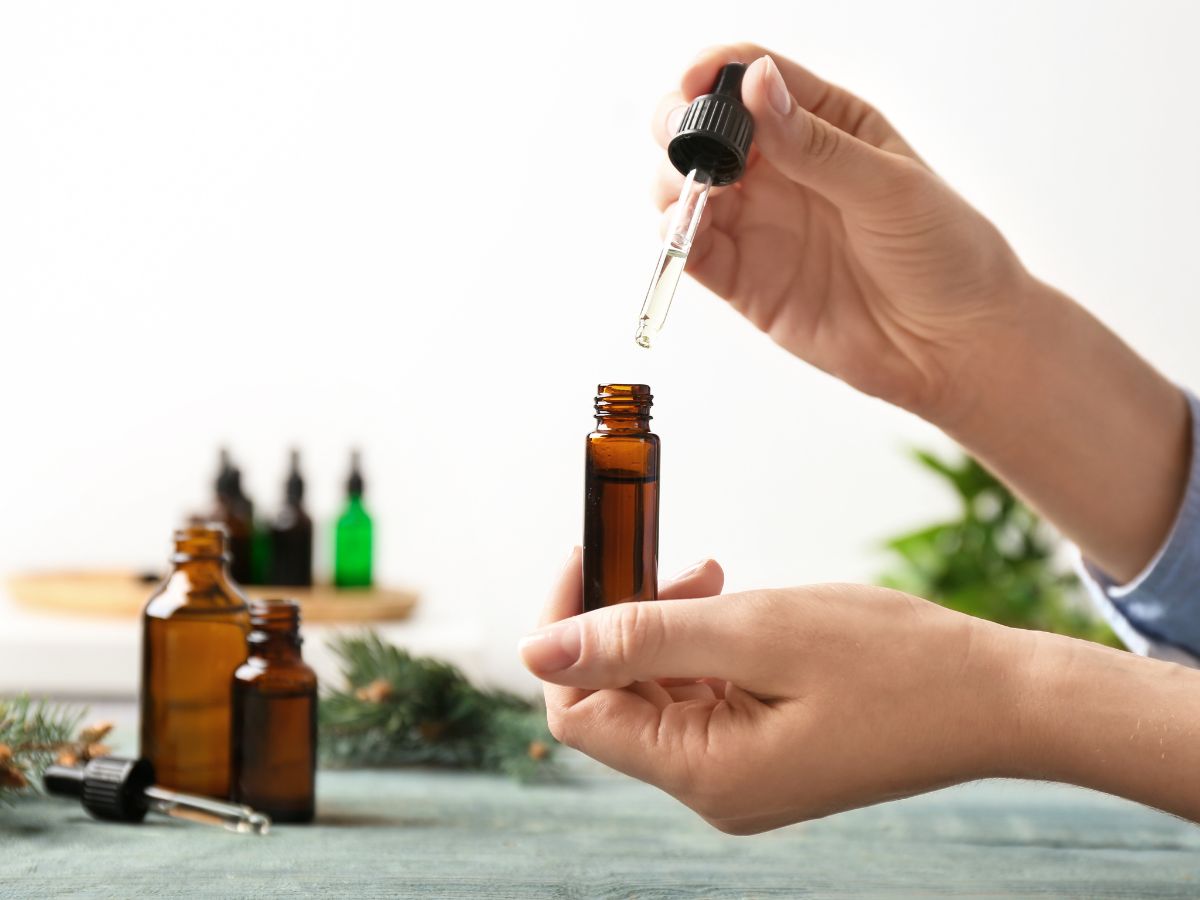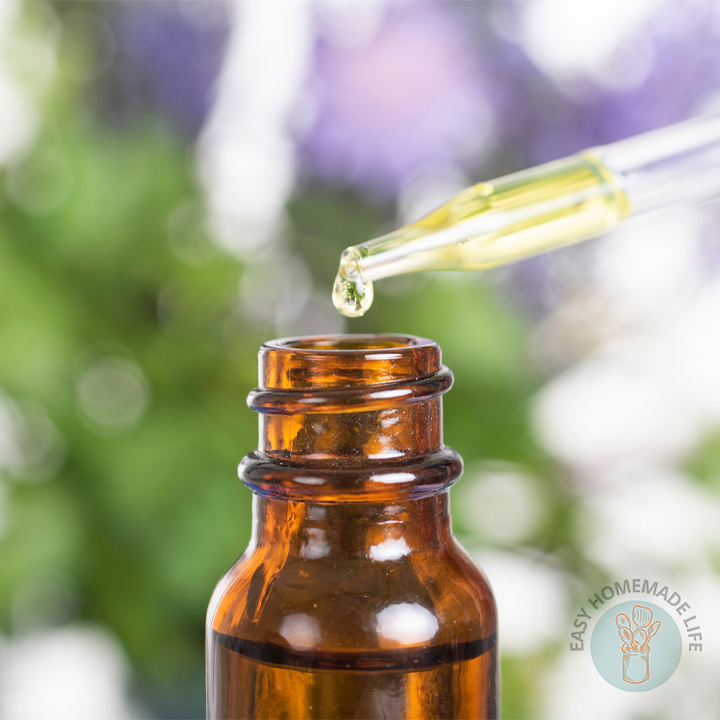Essential Oil Blends For Soap: 11 Easy Homemade Recipes
As a participant in the Amazon Services LLC Associates Program and other affiliate programs, Easy Homemade Life may collect a share of sales or other compensation from the links on this page. This comes at no additional cost to you, and all the prices and availability are accurate at the time of publishing.
There are so many essential oil blends for soap that it can get overwhelming for anyone who wants to try soap making for the first time. From energizing morning scents to soothing evening aromas, the options are endless for essential oil blend recipes – you can even create your own!
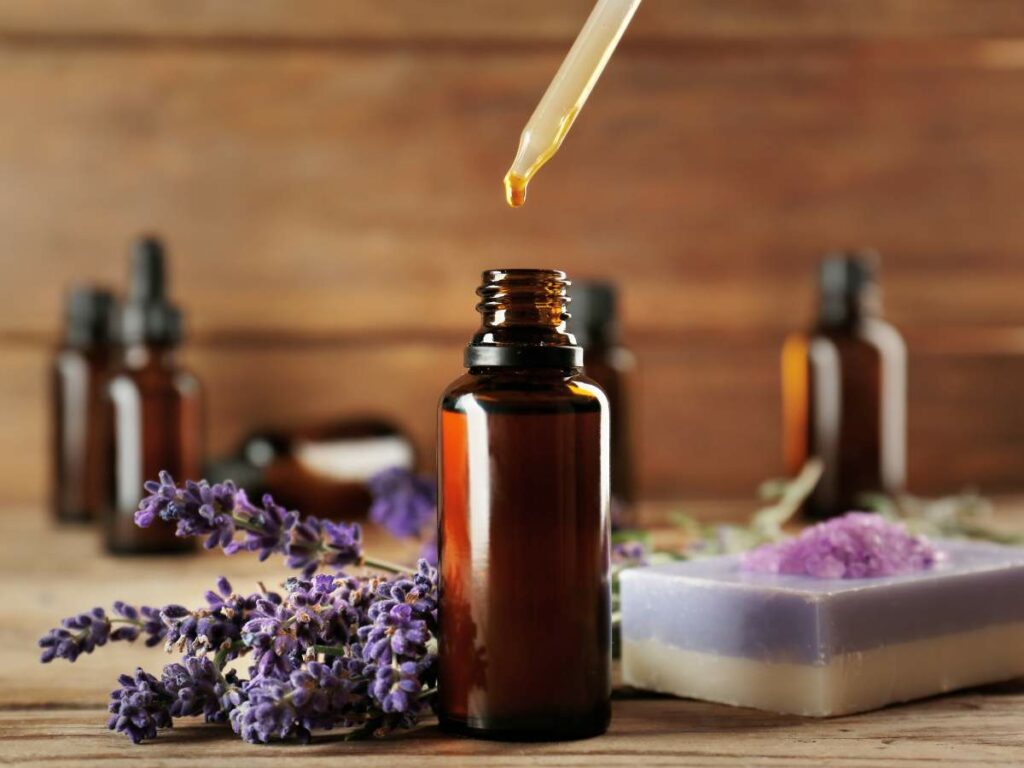
When I first tried to make my own handmade soap many years ago, I gathered my favorite essential oils, picked the ones with the most skin benefits, and experimented with different combinations until I discovered the best soap-safe scent blends which I’m excited to share with you today. Whether you’re new at soap making or simply looking for new essential oil blends for soap, get inspired by my tried and tested homemade recipes!
How To Use Essential Oils in Making Soap
If you’ve been following my blog, you know that I’m a big essential oils fan – I use them for treating my kids’ flu, in my laundry, and even in my own skin care. When I tried my hand at soap making, naturally I had to use my essential oils.
Good thing I’ve made plenty of essential oil blends like my winter, summer, and vanilla blends which I can use in soapmaking. To this day, I still make scented bar soaps and liquid hand soaps that friends and family love receiving on special occasions!
Infusing melt and pour soaps with your favorite blends of essential oils is surprisingly easy. Here’s how:
Step 1: Choose Your Essential Oils
Choosing the right essential oils for soap making is important so that you can create a pleasing fragrance and make sure that the end product is safe to use. Opt for oils that complement each other and consider the desired fragrance profile based on the intended use of the soap, whether you plan to use it for quick, refreshing showers or long, relaxing baths.
More importantly, use skin-safe essential oils that provide plenty of benefits to the skin. Here is a list of essential oils that are ideal for different skin conditions:
- Dry Skin: Chamomile, lavender, sandalwood
- Oily Skin: Clary sage, rosemary, frankincense, geranium, neroli
- Sensitive Skin: Lavender, frankincense
- Acne-Prone Skin: Lemon, lemongrass, cinnamon, tea tree
- Pigmentation: Pomegranate, carrot seed, orange, ylang ylang
- Anti-Aging: Rose, myrrh, patchouli, tangerine, sandalwood
Step 2: Measure and Mix the Essential Oils
Measure each essential oil and mix them together to create your scent. While there are recipes you can follow, you can add or subtract from the standard measurements based on personal preference and desired fragrance intensity. Keep in mind that essential oils are very concentrated, so you don’t need too much to achieve your desired fragrance.
Step 3: Prepare Your Soap Base
Cut your soap base into small cubes and melt either in the microwave or in a double boiler on the stovetop. Once your pour base is melted, be sure to move quickly because it will begin to harden immediately.
Step 4: Add the Essential Oils
Allow the soap base to cool a little then carefully add your chosen essential oils to it. Stir to combine. Stirring gently but swiftly will help ensure the oils are evenly dispersed. Here you can also add other ingredients you’d like to include in your soap like herbs, flowers, and coloring.
Step 5: Pour Into Molds and Harden
Pour the soap mixture into molds and allow to rest and harden for at least 45 minutes for best results. I like using silicone molds because it’s easy to remove the soaps once they are set. Once set, remove the soaps from the molds and store in a cool, dry place.
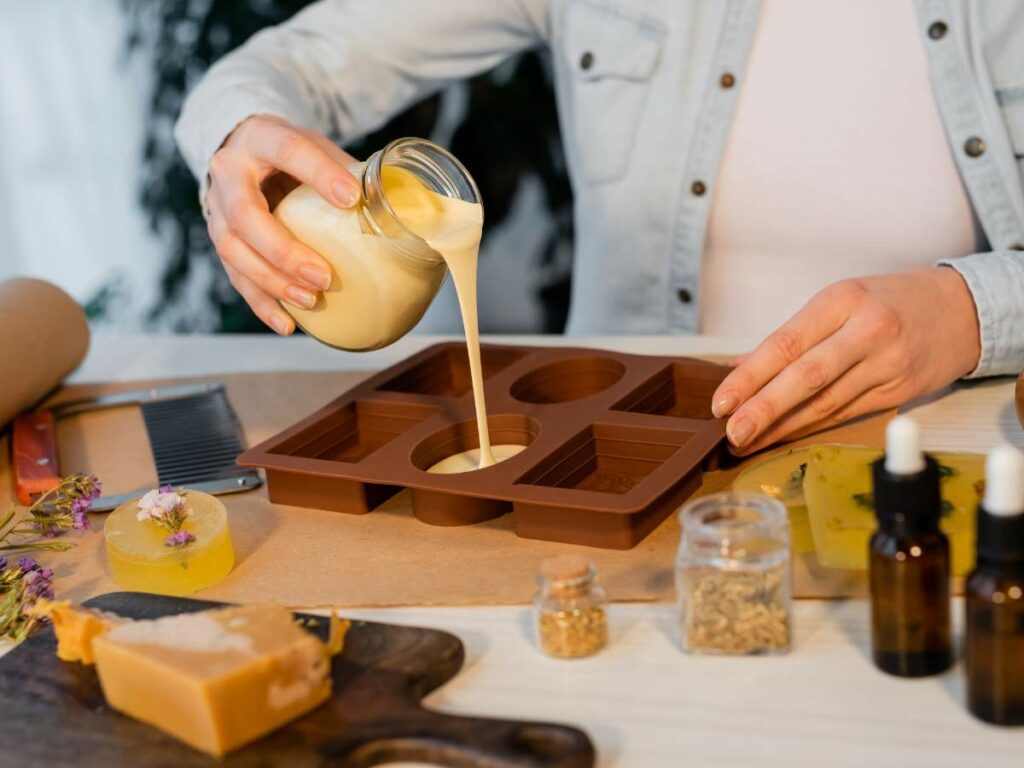
Quick Tips for Blending Essential Oils for Soap
We’re adding essential oils to our soap not just for fragrance purposes but for therapeutic benefits as well. Before blending essential oils for soap, here are a few important reminders:
Only Use High-Quality Oils
Since you or your loved ones will be using the soaps on your bodies, make sure you infuse them only with high-quality essential oils purchased from a reputable source. Choose oils that are pure, organic, and therapeutic grade to reduce the risk of skin irritation or adverse reactions. Additionally, 100% pure oils will have better scent retention in soaps because they have a strong and concentrated aroma. Stay away from fragrance oils, as those are most likely synthetic fragrances!
Be Mindful About Using Photosensitive Oils
There are some photosensitive essential oils that should be used sparingly in DIY soaps as they can increase skin sensitivity to sunlight and UV rays. Oils that have photosensitive properties include citrus oils (lemon, lime, grapefruit, sweet orange, mandarin, etc.), bergamot, and angelica.
While citrus essential oil blends can be diffused safely, use only a few drops of citrus oils in your soap. If you love these oils and want to keep using them, use the soap at nighttime or apply sunscreen before going outside during the daytime.
Use the Right Amount of Oils
Using the right amount of essential oils in your soap gives you a better chance of achieving your desired fragrance without overwhelming the senses or risking skin irritation. Putting too much oil can make the soap soft which will be difficult to solidify, while putting too little will leave your soap with a lackluster scent.
There is actually no one formula that we can follow for the right amount of essential oils to use in soaps, as well as the safe usage rate, because there are several factors to consider, including the soap making method, the type of soap, the kind of oil being used, and personal preferences.
The easiest way to go about it is to add the oils half a teaspoon at a time, allow the soap to cool, and test it out. If I want a strong scent, I melt down the soap, add more oils, and repeat the process until I’m satisfied with the fragrance. It’s really a try-and-test method that requires plenty of patience. Don’t forget to note down the exact measurements when you create a new recipe!
Add the Oils at the Right Time
Natural oils evaporate quickly, especially when exposed to heat. Too much heat impacts the quality of the oils and changes its chemical composition which makes it less effective. With this, be sure not to add the essential oils when the soap base is fresh out of the stove or microwave – wait for the base to be almost cool to the touch but not solidified before adding the oils.
Conduct a Patch Test Before Using New Essential Oil Blends
Before blending essential oils for soap, conduct a patch test to make sure they are safe to use on the skin. This is especially true if you have allergies or sensitive skin. To do this, dilute a small amount of the diluted essential oil blend to your inner forearm and wait at least 24 hours to see if skin irritation or allergic reaction occurs. If you experience any redness, itching, or discomfort, do not use the oil blend and consider using other recipes.
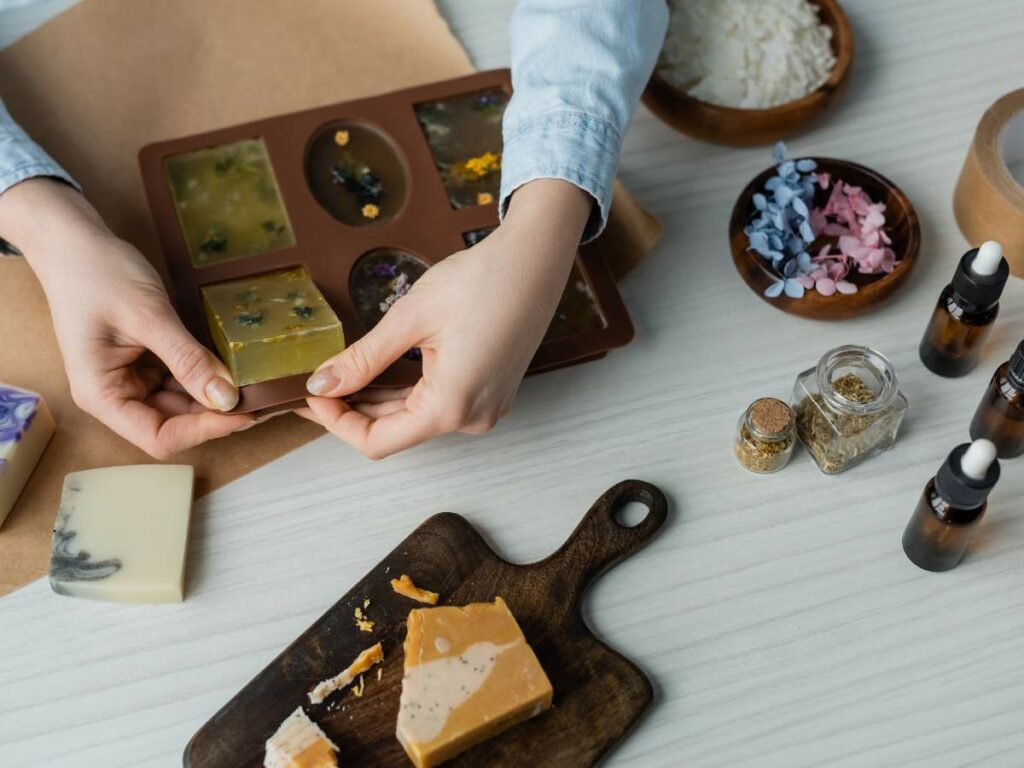
11 Easy Essential Oil Blend Recipes for Soap
Now here comes the best part – my tried and tested essential oil blends for soap! Elevate your soap-making experience with these homemade soap recipes that combine the delightful scents of essential oils while soothing and nourishing the skin.
Use these melt and pour soap recipes as guidelines only because I can’t tell you exactly how much oil you will need in your particular batch of soap. You may prefer a mild scent, or a strong one, so feel free to add or subtract from the recipe until you achieve your desired scent.
Lavender + Peppermint
This is the first bar soap recipe that I tried, and it was such a good choice! When it comes to natural oils, lavender essential oil is a superstar! This versatile oil has a floral aroma that is both calming and relaxing, that’s why it is often used in aromatherapy and in skin care products. I use it a lot whenever I make my essential oil blends for relaxation, too.
On the other hand, peppermint oil has a cooling and rejuvenating effect on the skin. It is also known to ease skin problems such as itchiness, irritation, and inflammation. Together, lavender and peppermint create a unique, refreshing scent that is calming, soothing, and energizing.
Recipe:
- 1 part lavender
- 1 part peppermint
Orange + Vanilla
Orange creamsicle, anyone? If you like clean and sweet scents, then this blend is for you. Orange essential oil is one of the most skin-friendly oils out there – it helps maintain skin health by promoting clarity, radiance, and smoothness of the skin. And who doesn’t like the familiar
chocolatey smell of vanilla? Vanilla essential oil has excellent anti-aging properties. It also helps brighten dry, dull, and tired skin.
When combined, you’ll get a sweet and pleasing scent that reminds you of summer time, while keeping your skin . Sometimes I add a few drops of cinnamon because spices always enhance orange blends!
Recipe:
Spearmint + Patchouli
With its crisp, sweet scent reminiscent of fresh mint leaves, spearmint is an ideal skin cleanser. It supports skin health by enhancing the skin’s elasticity and resilience. Its cooling effect helps relieve itching from skin dryness and irritation. In contrast, patchouli has a deep, earthy, and musky scent that is both balancing and grounding. This oil has powerful anti-aging properties that leave your skin glowing and radiant. The freshness of spearmint and the warmth of patchouli makes a soap scent that grounds the mind but uplifts the spirit – perfect for a long bath after a stressful day.
Recipe:
- 4 parts spearmint
- 1 part patchouli
Grapefruit + Geranium
Looking for a “brighter” aroma for your soap? Mix the zesty, citrus scent of grapefruit with the rosy, floral fragrance of geranium. Grapefruit essential oil is believed to help fight acne and improve the appearance of skin blemishes. Geranium also has similar effects on the skin – it has antibacterial and antiseptic properties that help reduce scars caused by acne. So if you want smooth and blemish-free skin, you would benefit from this blend, especially if you’re prone to acne.
Recipe:
- 1 part grapefruit
- 1 part geranium
Cedarwood + Patchouli + Bergamot
Another ideal blend for acne-prone skin is the combination of cedarwood, patchouli, and bergamot. Cedarwood essential oil has a warm and woodsy aroma that evokes feelings of strength and stability. According to the Journal of Alternative and Complementary Medicine, this oil is effective at treating acne and preventing breakouts. Bergamot is a great essential oil has a unique spicy citrus scent that is reminiscent of Earl Grey Tea. This uplifting oil is known to help fight acne. Add the earthy scent of patchouli and you get a beautifully balanced fragrance and a soap that leaves your skin clear and youthful.
Recipe:
Clary Sage + Roman Chamomile + Myrrh
Need a soap blend that will help you relax? Combine clary sage, Roman chamomile, and myrrh! Clary sage offers a slightly sweet herbal and floral scent that’s calming and uplifting. Roman chamomile has a gentle, floral fragrance that is soothing for both the mind and body. Myrrh contributes a warm and woody aroma that is slightly smoky and spicy, giving a sense of comfort.
All three essential oils promote healthy and blemish-free skin, and you get a soap scent that helps clear the mind, calm the senses, and ease tension – perfect for a relaxing nighttime bath before bed.
Recipe:
- 2 parts clary sage
- 2 parts Roman chamomile
- 3 parts myrrh
Lime + Clementine + Ylang Ylang
The combination of lime, clementine, and ylang ylang essential oils make an energizing soap for your morning bath! The refreshing zesty citrus scent of lime indicates that it’s packed with Vitamin C, which helps protect the skin from free radical damage. Clementine has a sweet and fruity aroma and provides the same skin benefits as lime. Ylang ylang has a unique floral fragrance with hints of spice and warmth. It is best known for balancing and regulating oil production in the skin. Together, they create a bright fragrance that’s like a burst of sunshine – perfect to start your day!
Recipe:
- 2 parts lime
- 2 parts clementine
- 1 part ylang ylang
Tea Tree + Lemongrass + Eucalyptus
You’re probably familiar with tea tree oil because it’s widely used in skincare products. It promotes healthy glowing skin among many other benefits. Lemongrass essential oil has acne-fighting properties and is ideal for cleansing and purifying the skin. Eucalyptus essential oil is best known for treating and preventing acne. When blended together, they create a fusion of citrus, herbal, and minty notes that can instantly boost your mood, resulting in a soap that’s great for daily use.
Recipe:
- 1 part tea tree
- 2 parts lemongrass
- 1 part eucalyptus
Sandalwood + Patchouli + Sweet Orange
Another blend that can instantly improve your mood and uplift your spirits is the sandalwood, patchouli, and sweet orange blend. Combine the warm, woody, and creamy scent of sandalwood with the sweet and juicy aroma of sweet orange essential oil and the warm and musky scent of patchouli and you get a long-lasting fragrance that promotes balance, energy, and emotional well-being. So if you’re feeling down, take a shower with this soap and you’ll be smiling in no time!
Recipe:
- 1 part sandalwood
- 1 part patchouli
- 6 parts sweet orange
Frankincense + Coffee + Cardamom
Frankincense, which is great for reducing skin inflammation, has an earthy, piney, and somewhat balsamic scent. Coffee essential oil, which is known for helping keep the skin young-looking by reducing fine lines and wrinkles, offers that rich and delicious aroma that we are all familiar with. Cardamom, known for cleansing the skin and preventing breakouts, has a nice sweet and spicy fragrance. When blended together, they make a soap that promotes clarity, focus, and emotional well-being.
Recipe:
- 2 parts frankincense
- 2 parts coffee
- 1 part cardamom
Neroli + Bergamot + Tangerine
This soap blend is great for daily use, as it wakes the senses and promotes positivity. Neroli, with its sweet and floral scent, is one of the best essential oils to use on your skin. It’s anti-aging, hydrating, and moisturizing. It’s excellent at regenerating the skin and protecting it from free radicals. Tangerine essential oil, with its sweet and tangy aroma, also provides similar benefits, on top of calming upset skin and balancing its complexion. Add the acne-fighting properties of bergamot and you’ll have a go-to soap for achieving clear, smooth, and radiant skin!
Recipe:
Wrapping Up
The beauty about essential oil blends for soap is that you are free to use different oils you like and you have the freedom to mix, match, add, and subtract from recipes so that the fragrance suits your needs, taste, and preferences. At the same time, you can choose a pure essential oil that can target your skin problems like acne-prone, dry, or dull skin. Making your own soap is a great way to start using natural products that would do wonders for your skin.
Ready to start making soaps? If you found this post helpful, please bookmark it or share it with family and friends who might like to try their hand at soap making!
How To Use Essential Oils in Homemade Soap Bars
Equipment
- 1 Microwave-safe bowl
- 1 Fork or whisk
- 1 Microwave or double boiler
- 1 Silicone soap molds
Materials
- 40 drops essential oil or oil blend, up to 60 drops
- 1 block melt and pour soap base
Instructions
- Choose the essential oils you plan to use for your soap. Opt for oils that complement each other and consider the desired fragrance profile based on the intended use of the soap.
- Measure each essential oil and mix them together to create your desired scent.
- Cut your soap base into small cubes and melt either in the microwave or in a double boiler on the stovetop.
- Allow the soap base to cool a little then carefully add your chosen essential oils to it. Stir to combine. Here you can also add other ingredients you’d like to include in your soap like herbs, flowers, and coloring.
- Pour the soap mixture into molds and allow to rest and harden for at least 45 minutes. Once set, remove the soaps from the molds and store in a cool, dry place

